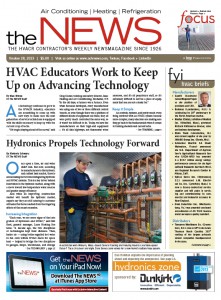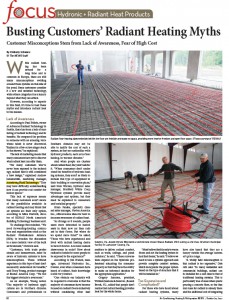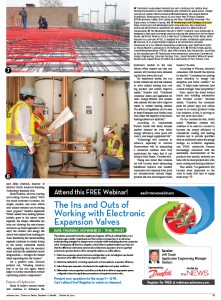 As seen in ACHR the NEWS and on www.achrnews.com - October 28, 2013
As seen in ACHR the NEWS and on www.achrnews.com - October 28, 2013
Customer Misconceptions Stem from Lack of Awareness, Fear of High Cost
While radiant heating has been around for a long time and is common in Europe, there are still many misconceptions swirling around these systems on this side of the pond. Some customers consider it a new and untested technology, while others categorize it as a luxury beyond what they can afford.
However, according to experts in this field, it’s time to bust these myths and introduce radiant heat to the masses.
Lack of Awareness
According to Paul Pollets, owner of Advanced Radiant Technology in Seattle, there has been a lack of marketing
of radiant technology and its benefits. He compared the problem to someone with an amazing voice whose talent is never discovered. “Radiant is a five-octave singer stuck in the shower,” he explained.
The lack of marketing means that many consumers have yet to discover what radiant heat can offer them.
 “For many customers who’ve never been exposed to the technology, radiant heat is still considered a ‘new design,’” explained Andrew Januszewski, marketing manager, Armstrong Fluid Technology. “They may have difficulty understanding how it can provide real comfort for indoor spaces.”
“For many customers who’ve never been exposed to the technology, radiant heat is still considered a ‘new design,’” explained Andrew Januszewski, marketing manager, Armstrong Fluid Technology. “They may have difficulty understanding how it can provide real comfort for indoor spaces.”
This lack of exposure means that many customers aren’t aware of the possibilities available in radiant heating and may think that air systems are their only option, according to Mike Dietrich, director of REHAU North America’s
Building Technology business unit.
To challenge this mindset, “We need forwarding-looking contractors and organizations such as the Radiant Professionals Alliance (RPA) to broaden the discussion to a more holistic view of the built environment,” Dietrich said.
“Customers, both trade professionals and homeowners, must be aware of hydronic systems to have misconceptions. Those without experience in this type of heat don’t necessarily understand its benefits,” said Tracy Young, product manager at Rinnai America Corp. “We feel the biggest obstacle is wareness.”
 As an example, Young noted: “The majority of hydronic applications are in Northern climates. Consumers and professionals in Southern climates may not be able to justify the cost of such a system, as they are unfamiliar with hydronic products, such as in-floor heating, in warmer climates.”
As an example, Young noted: “The majority of hydronic applications are in Northern climates. Consumers and professionals in Southern climates may not be able to justify the cost of such a system, as they are unfamiliar with hydronic products, such as in-floor heating, in warmer climates.”
And when people are clueless about radiant heat, they don’t ask for it. “When consumers don’t understand the benefits of hydronic heating systems, they aren’t as likely to include this type of equipment in their building or renovation plans,” said Nate Warren, hydronic sales manager, Bradford White Corp. “Hydronic systems provide many advantages and options, but they must be explained to consumers and installed properly.”
Brian Fenske, specialty channel sales manager, Navien America Inc., offered some ideas for how to increase awareness of radiant heat.
“As strange as it sounds, people seem more interested in heated seats in their new car than radiant in their floors. But where do we spend more time?” he asked. “Those who have experienced and lived with radiant heating desire to have it forever. Are more radiant showrooms in order? How about radiant in hotels for more people to be exposed to the experience?”
According to Jim French, manager, Advanced Hydronics Inc., Denver, even when consumers have heard of radiant, their knowledge is still very limited.
 “One obstacle our industry will be required to overcome is that the majority of consumers have become focused on radiant floors exclusively without considering other heat emitters to deliver radiant comfort, such as walls, ceilings, and panel radiators,” he said. “These conversations depend on the hydronic professional educating the consumer properly so that they have the ability to make an informed decision for the appropriate application.”
“One obstacle our industry will be required to overcome is that the majority of consumers have become focused on radiant floors exclusively without considering other heat emitters to deliver radiant comfort, such as walls, ceilings, and panel radiators,” he said. “These conversations depend on the hydronic professional educating the consumer properly so that they have the ability to make an informed decision for the appropriate application.”
Gregory Jannone, president, William Jannone & Sons Inc., Bound Brook, N.J., added that people don’t realize that radiant heating provides heat for the whole home.
“Most believe that it is only to warm floors and not the heating system to heat their home,” he said. “I believe we
need to take a systems approach and provide complete comfort systems, which incorporate the proper system
based on the type of structure that it will be installed in.”
Too Expensive and Complicated?
For those who have heard about radiant heating systems, many have also heard that they are a luxury outside the average customer’s price range.
“A widely held misconception is that radiant is too expensive,” Dietrich said. “In many residential and commercial buildings, radiant can be installed for a cost close to that of traditional heating systems. This is particularly true of cases where you’re pouring a concrete floor, so the thermal mass for radiant is already there and the additional cost of integrating areas heated with hydronic space heaters, and in toe-kick hydronic heaters in kitchens and hydronic convection heaters used to supplement heat in great rooms with a lot of glass on exterior walls.”
He continued: “More recently, chilled beams and variable air volume (VAV) technology have brought them together. In fact, another bridging technology — radiant cooling — can be used in ceilings, walls, and floors.”
John Sweaney, senior product and customer support manager, Watts Radiant/Suntouch, agreed this is a current trend driving innovation. “Today, we rarely see standalone radiant heat systems; they’re often integrated with forced air.”
Low-Temp Trend
Another trend observed by many in the industry is a greater use of low-temperature heat sources.
According to John Barba, residential training/trade program manager, Taco Inc., the use of low water temperature heat emitters is not new. However, he said, “Some of the emitters are very interesting.”
According to Barba, “There’s now low-temperature fin-tube baseboard available that can deliver 400-500 Btuh per linear foot with 120° -130°F water. They are assembled, ready-to-install panels for radiant ceilings. These assemblies are remarkable, capable of delivering up to 27 Btuh per square foot of radiator space at only 100° water.”
Dietrich noted that this trend is related to the new, highly efficient boilers on the market.
“The growing popularity of condensing boilers makes low-temperature radiant distribution highly complementary
and a perfect match for modern boilers,” he said.
Sweaney added, “We’re seeing a lot of water-to-water and even air-to-water heat pumps as the source for hydronic warmth, ideally matched to the low-temp needs of radiant heat systems.”
Jim Fino, marketing manager, Harsco Industrial Patterson-Kelley, said condensing hot water is driving the market, noting that a new product roll-out from his company is focused on offering a low boiler water approach temperature compared to the domestic hot water set point.
Energy Efficiency
Along with these trends, it’s impossible to discuss the hydronics market without mentioning how it is being affected by the drive for ever-improving energy efficiency. “We are seeing great interest in the market for energy-efficient solutions,” said Andrew Januszewski, marketing manager, Armstrong Fluid Technology.
“As efficiency standards become more stringent, the trend to manufacture more efficient equipment increases as well,” added Tracy Young, product manager at Rinnai America Corp.
Brian Fenske, specialty channel sales manager, Navien America Inc., also commented on the move toward efficiency. “Energy efficiency and equipment size continues to draw interest from the designer and installer, but the consumer also,” he said. Fenske added that this is leading to the development of “new burners, heat exchanger designs, and parameter settings that will allow fine tuning in the field to reduce cycling of lowmass condensing boilers that otherwise are perfect in reducing standby losses that lowers the AFUE.”
According to Kevin Graebel, senior product manager, water, Honeywell, “The convenience and ease of installation of the control panels will drive adoption of higher-efficiency systems.”
But it’s not just residential consumers seeking energy efficiency — the same desire exists for commercial consumers. “Our customers demand the most energy-efficient, intelligently designed cooling and
heating systems available for their commercial applications,” said Mike Smith, senior marketing manager, commercial products, Mitsubishi Electric US Cooling & Heating Division. “We use our hydronic products
to maximize energy efficiency, providing additional energy-saving components to variable refrigerant flow (VRF) zoning systems.”
Considering all of the advances in efficiency, Nate Warren, hydronic sales manager, Bradford White Corp., added a note of caution for contractors. “As heating systems, controls, and equipment become more advanced, it’s important for contractors to understand how they work as a whole,” he said. “As a manufacturer, we see a lot of great examples of our reps and wholesalers spending more time educating contractors. Being familiar and comfortable with the product helps the installer do the job right the first time, which is good for everyone.”
Economic Effects
Energy efficiency also ties well into the post-recession mindset of consumers seeking to save money on energy bills. Whether you call this being “cost-competitive” or “affordable” (but never “cheap”), it’s clear that customers are still looking for ways to get the most bang for their buck.
“Not surprisingly, the primary trend for the past few years is a greater focus on value. The push toward sustainability has survived the recession, but you have to deliver value, especially in initial investment and operating costs,” said Mike Dietrich, director of REHAU North America’s Building Technology Business Unit.
Mark Hudoba, director, heating and cooling, Uponor, added, “With the recent economic recession, the simple, smaller, and more affordable radiant systems are becoming more popular.” Hudoba explained: “While radiant floor heating systems initially grew in the luxury home segment, the simple, affordable systems are allowing the entry-luxury and move-up home segments to also enjoy the comfort and energy efficiency that radiant floor heating provides. Essentially, the radiant heating segment continues to remain strong in the luxury residential market
while expanding into the standard home and also the residential remodeling markets — strong in the ‘classes’
while expanding into the ‘masses.’”
On a positive note, Dietrich pointed out, “Housing construction is on the rise again, which helps to further innovation toward optimizing system components.”
Future of Hydronics
Many of today’s current trends will continue to influence the hydronics market in the near future, while experts say that consumers will become more demanding further down the road.
“As mentioned earlier, the economic climate has and will continue to drive radiant heating and cooling product and system improvements,” Hudoba said. “Continued consumer desire and legislation for more energy-efficient and sustainable systems will also drive improvements to radiant heating systems. The effects of legislation can be seen in many European and Nordic countries where the majority of the home-heating systems are hydronic.”
According to Januszewski, “Future trends will likely include market demand for even better energy efficiency, more space efficiency, and longer equipment life.”
“Technology will continue to advance, especially in controls. Homeowners will be demanding a connected solution once they understand the value that it can bring to their home,” Graebel said.
Young also noted that consumers will become more demanding. “Additional features and benefits consumers will demand from product manufacturers include longer product life and less frequent maintenance,” he said.
According to Warren, educated consumers will benefit the hydronics market. “Consumers are paying more attention to energy consumption and better comfort,” he said. “It helps make hydronic heat a much stronger value proposition.”
“Also, there’s the trend toward home and building automation and wireless access,” Sweaney added. “Consider the consumer push for phone apps and online access to so many products today. Our industry, at last, is moving in the very same direction.”
On the commercial side, Smith noted: “Hydronic systems will continue to be used as a means to increase the energy efficiency of commercial cooling and heating systems and to provide specifiers with an additional option for energy savings. As architects, engineers, and HVAC contractors become increasingly concerned with the sustainable characteristics of the products they specify, hydronic systems will be incorporated into even
more cooling and heating solutions.”
Fino added, “Co-generation will become more important as the costs to make this type of equipment drop.”



